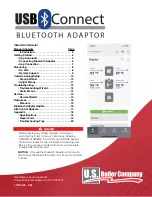
4
5
kewtechcorp.com
kewtechcorp.com
Avoid any heating up of the instrument by direct sunlight to ensure perfect
functioning and long instrument life.
The opening of the instrument for fuse replacement, for example, may only be
carried out by professionals. Prior to opening, the instrument has to be switched
off and disconnected from any current circuit.
The instrument may only be used under those conditions and for those purposes
for which it was conceived. For this reason, in particular the safety references,
the technical data including environmental conditions and the usage in dry
environments must be followed.
When modifying or changing the instrument, the operational safety is no longer
ensured.
Testing of the charging station
PE Pre-Test
Prior to all other tests the PE pre-test must be successfully carried out. Never touch
PE terminals at the mains socket on the back of the adapter before the PE pre-test is
successfully finished.
The PE Pre-test allows the operator to test the PE conductor for the possible presence
of dangerous voltage against earth.
Normally the PE conductor is connected to earth and has no voltage against earth.
In a situation where the PE conductor is not connected to earth (mistakingly connected
to phase or possibly broken) the user is exposed to a ‘danger to life’ situation.
Test procedure:
- Connect the test adapter to the charging station
- Touch the touch pad (no. 6) with a bare finger
- If the light indicator (no. 5) is illuminated then a dangerous voltage is present at the
PE conductor. Stop further testing immediately and remedy the wiring fault.
Do not wear gloves while performing this test and ensure a proper connection to earth.
Never touch any metal parts during this test. In the case of improper earthing (e.g.,
operators body is isolated from the earth) this test may be not reliable.
Proximity Pilot (PP) State (Cable Simulation)
Using the PP State rotary switch, the current ratings of the charging cable can be simulated.
Current ratings are simulated with different resistances connected between PP and PE
conductors. Correlation between resistance and current ratings of the charging cable is
shown in the table below.
TABLE 1
Cable current rating
Resistance between PP and PE
No cable
Open (�)
13 A
1.5 k �
20 A
680 �
32 A
220 �
63 A
100 �
Control Pilot (CP) State (Vehicle Simulation)
Using the CP State rotary switch selector various vehicle states can be simulated. Vehicle
states are simulated with different resistances connected between CP and PE conductors.
Correlation between resistance and vehicle states is shown in the table below.
TABLE 2
Vehicle State State Description
CP-PE Resistance CP terminal voltage
A
Electric vehicle not connected
Open (�)
±12V @ 1KHz
B
Vehicle connected, not ready to charge
2.74K
+9V/-12V @ 1KHz
C
Electric vehicle connected, ready to charge,
ventilation not required
882�
+6V/-12V @ 1KHz
D
Electric vehicle connected, ready to charge,
ventilation required
246�
+3V/-12V @ 1KHz
CP Signal output terminals
CP signal output terminals are connected to the CP and PE conductors of the tested charging
station via the test cable. (No. 4)
Use an oscilloscope to check the waveform and amplitude of the CP signal.
The Control Pilot function uses Pulse Width Modulation (PWM) to code communication
between a vehicle and charging station. The duty cycle of the PWM signal defines the possible
available charging current, while amplitude defines charger state.
For details of communication protocol please refer to IEC/EN 61851-1 and the
documentation of the manufacturer of the charging station.
Important note: In the case of incorrect wiring of the charging station, the signal
CP test terminals can become a high live hazardous voltage.
CP Error “E” simulation
“E” - CP Error simulation button (no. 7). With the CP Error “E” button pressed the operator
can simulate behaviour of the station when there is a short circuit between CP and PE
through an internal diode (acc. to standard IEC/EN 61851-1). When the ‘CP Error - E’ button
is pressed the charging process should be aborted and further charging is prevented.
F























